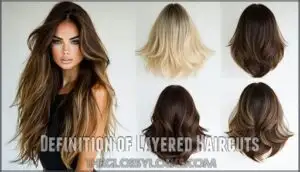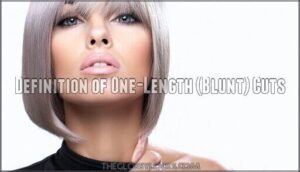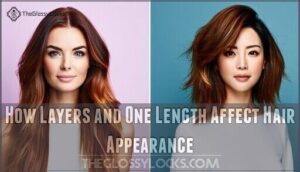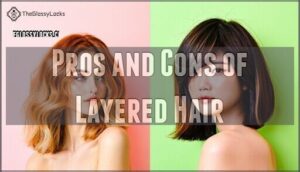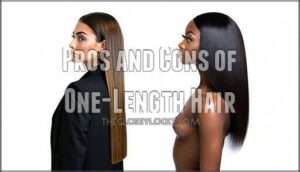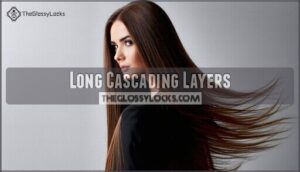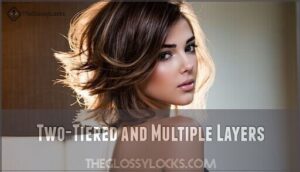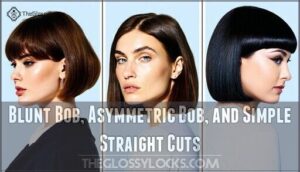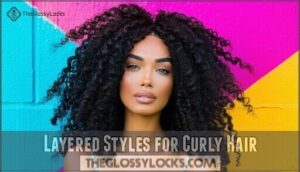This site is supported by our readers. We may earn a commission, at no cost to you, if you purchase through links.
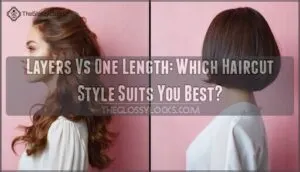 Layers versus one length? It’s really about whether you want movement or sleekness.
Layers versus one length? It’s really about whether you want movement or sleekness.
Layered cuts give you volume and texture with hair cut at different angles – they’re great for thick hair that needs control or fine hair that wants more body.
One-length cuts maintain uniform thickness with a straight-across technique, giving you that polished, low-maintenance look that’s especially flattering for fine hair since it maximizes density.
Layers need trims every 6-8 weeks and more styling products, while one-length cuts offer simplicity but limited versatility. Your hair type, lifestyle, and styling patience will determine which path leads to your perfect cut.
Table Of Contents
- Key Takeaways
- Layers Vs One Length: Key Differences
- Pros and Cons of Layered Hair
- Pros and Cons of One-Length Hair
- Popular Types of Layered and One-Length Cuts
- Choosing The Best Cut for Your Hair
- Frequently Asked Questions (FAQs)
- What are some tips for styling layered hair?
- Is it difficult to maintain a one-length haircut?
- How often should I get my one-length haircut trimmed?
- Are there any benefits to having a layered vs. one-length hairstyle?
- Can layers work with every face shape?
- How much does layered styling cost monthly?
- Which cut grows out more gracefully?
- Do layers cause more hair breakage?
- Can you fix badly done layers?
- Conclusion
Key Takeaways
- You’ll get more volume and movement with layers, but they require trims every 6-8 weeks and need more styling products to look their best.
- One-length cuts give you a sleek, polished look that’s lower maintenance and can make fine hair appear thicker by maximizing density.
- Your hair type determines which works better – layers suit thick hair that needs taming or fine hair craving body, while one-length cuts excel on fine hair.
- Consider your lifestyle when choosing – layers offer styling versatility but demand more daily effort, while one-length cuts provide simplicity with limited styling options.
Layers Vs One Length: Key Differences
Understanding the key differences between layered and one-length cuts helps you choose the right haircut for your next salon visit.
Layered cuts feature hair strands cut at varying lengths to create movement and volume, while one-length cuts maintain a uniform length across all sections for a sleek, blunt appearance.
Definition of Layered Haircuts
Layered haircuts feature multiple hair-cutting techniques that create varying lengths throughout your hair. Think of them as strategic steps cascading down your head. The layering process involves cutting different sections at graduated angles, creating depth and dimension. This cutting technique transforms flat hair into versatile styling options, giving you freedom to embrace your hair texture‘s natural movement and volume.
| Layer Type | Cutting Angle | Best Hair Texture |
|---|---|---|
| Long Layers | 45-90 degrees | Thick, coarse hair |
| Short Layers | 90-180 degrees | Fine, straight hair |
| Face-Framing | Variable angles | All textures |
| Choppy Layers | Sharp angles | Wavy, textured hair |
| Feathered Layers | Soft angles | Medium thickness |
Definition of One-Length (Blunt) Cuts
One-length cuts, often called blunt cuts, create a straight, uniform edge across your hair. Unlike layered arrangements, every strand reaches the same length, forming a clean line. This cutting technique works especially well for fine hair texture, as it maximizes the appearance of thickness and density.
| Feature | One-Length Cut |
|---|---|
| Hair Texture Effect | Enhances thickness appearance |
| Blunt Cut Benefits | Clean, sleek finish |
| Cutting Techniques | Straight-across method |
| Styling Options | Minimal daily maintenance |
| Face Framing | Strong, geometric lines |
How Layers and One Length Affect Hair Appearance
Different cutting techniques change how your hair looks and feels in surprising ways. Layers add movement and make colors pop by catching light differently, while blunt cuts give you that sleek, polished look but fewer styling choices.
| Aspect | Layered Cuts | One-Length Cuts |
|---|---|---|
| Hair Thickness | Creates volume illusion | Maintains natural density |
| Face Framing | Customizable angles | Uniform perimeter |
| Color Enhancement | Multi-dimensional depth | Solid color blocks |
Pros and Cons of Layered Hair
Layered haircuts offer significant advantages like increased volume and movement, but they come with trade-offs you should consider.
You’ll need more frequent trims every 6-8 weeks and additional styling products, while potentially experiencing increased dryness compared to simpler cuts.
Volume and Movement Benefits
Through strategic stratification, layers create an instant volume boost by removing weight from your hair’s length. Each layer catches light differently, generating natural movement that makes fine hair appear thicker.
This cut enhancement works especially well with volumizing styling products and proper movement techniques, transforming flat hair texture into lively, bouncy locks that move freely with every step.
Maintenance and Styling Needs
Before committing to layers, understand they demand more effort than you might expect. Layering fundamentally changes how you approach your hair routine. Your hair regimen transforms completely with layered texture, requiring consistent daily upkeep to prevent unruly mornings.
You’ll need hair trimming every 6-8 weeks to maintain shape and prevent awkward growing-out phases. Styling products become essential – volumizers, mousse, and texturizing sprays join your arsenal. Extra time each morning blow-drying and styling individual layer sections becomes the norm. Heat protection products are mandatory due to increased styling frequency.
Professional cuts cost more due to sophisticated layering techniques requiring skilled stylists. The thickness illusion layers create comes with a price – your styling routine doubles compared to one-length cuts.
Potential for Hair Damage or Dryness
Frequent heat styling with layers breaks down hair’s protective proteins, creating microscopic damage. You’ll notice increased hair breakage and split ends as layers require more styling products and tools. This constant manipulation reduces hair moisture retention, leading to dry scalp and compromised frizz control across different hair material thickness levels. Understanding the effects of hair styling procedures is vital for maintaining healthy hair.
| Damage Factor | Layered Hair Impact | Prevention Strategy |
|---|---|---|
| Heat Exposure | 89% show microscopic damage | Use heat protectant products |
| Split Ends | Travel upward if untreated | Trim every 6-8 weeks |
| Protein Loss | Alpha-keratin denaturation | Limit styling frequency |
| Moisture Loss | Reduced water content | Deep conditioning treatments |
| Breakage Risk | Higher in shorter layers | Gentle brushing techniques |
Pros and Cons of One-Length Hair
You’ll discover that one-length cuts offer a sleek, polished appearance while reducing split ends by up to 22% compared to layered styles.
However, this classic approach comes with styling limitations and requires careful consideration of your face shape and hair texture.
Sleekness and Split End Reduction
Smoothness becomes your hair’s best friend with one-length cuts. This sleek style naturally prevents split ends by maintaining even hair thickness throughout each strand. You’ll notice less hair breakage since every strand receives equal protection from neighboring hairs.
- Frizz control: Uniform length creates natural weight that keeps hair sleek and manageable
- Split end prevention: Even cutting reduces weak points where hair usually breaks
- Enhanced hair texture: Consistent thickness gives fine hair more apparent fullness
- Simplified hair styling: Less layering means fewer styling products needed for smooth results
Growth, Health, and Maintenance
One-length cuts promote healthier hair growth by reducing hair breakage at varying lengths. Your scalp receives better root health circulation when hair grows uniformly.
Like a plant in horticulture maintaining consistent growth patterns, your hair experiences less stress without layer variations.
Hair nutrition reaches ends more effectively in one-length styles. You’ll notice fewer split ends since all strands endure equal tension and styling stress.
Styling Limitations and Face Shape Considerations
Just like keeping a garden neat and tidy, your hair stays healthier when it’s all the same length instead of having different layers.
Round facial structures benefit from angled cuts, while square faces need softening techniques.
Personal style matters—if you’re someone who enjoys experimenting with different looks, one-length hair limits your creative options compared to adaptable layered styles.
Popular Types of Layered and One-Length Cuts
You’ll find several distinct styles within both layered and one-length categories that can transform your look completely.
Understanding these popular cuts helps you communicate effectively with your stylist and choose the option that works best for your hair type and lifestyle.
Long Cascading Layers
Cascading layers create natural movement that flows like a waterfall down your hair. This layering technique involves gradually cutting each layer longer than the one above it, creating smooth transitions perfect for long hair.
Knowing these cut styles makes it much easier to tell your stylist exactly what you want and pick something that actually works with your hair and daily routine.
- Start with damp hair – Clean, towel-dried hair shows true texture for accurate cutting
- Section horizontally – Create clean partings every 2-3 inches from crown to nape
- Use point-cutting technique – Angle scissors to soften harsh lines between layers
- Maintain consistent tension – Keep each section taut while cutting for even results
- Blend thoroughly – Check transitions by combing through each completed section
Two-Tiered and Multiple Layers
When you’re ready to break free from basic layering, tiered cuts offer refined dimension through multiple distinct layers.
These layering techniques create structured thickness variations that enrich your hair texture beautifully. Multiple layers work like geological stratum—each level adds visual weight and movement.
Professional stylists strategically place each layer to boost volume and create stunning cascading effects that complement your unique features.
Blunt Bob, Asymmetric Bob, and Simple Straight Cuts
Multiple layers create thickness variations that add richness to your hair’s natural texture.
Think of it like geological layers—each cut adds weight and helps your hair move with more dimension.
Bob Hair Trends showcase blunt cuts that create sharp, geometric lines, while Asymmetric Styles add modern edge through uneven lengths.
These Straight Cut Variations work like custom clothing—structured yet adaptable.
Face Shape Analysis guides Haircut Personalization, securing each layer of your style flatters your features perfectly.
Layered Styles for Curly Hair
Straight cut variations adapt to different face shapes and personal styles, much like a well-tailored piece that looks effortless but requires precise execution.
- Long cascading layers – Reduce weight while maintaining length, allowing curls to spring up naturally
- Face-framing layers – Create movement and prevent the dreaded triangle effect that plagues 68% of curly-haired clients
- Custom curl-by-curl cutting – Tailors each layer to your specific curl pattern and hair texture analysis needs
Understanding your curl type guide is essential for determining the best layering technique for your hair.
Choosing The Best Cut for Your Hair
You’ll need to factor in your hair type, lifestyle, and styling preferences when selecting between layers and one-length cuts.
Your texture, thickness, and daily routine determine which option works best for your specific needs.
Hair Type and Texture Considerations
When choosing between layers and a one-length cut, consider how your hair’s natural texture and thickness will work with each style.
Think about how much time you want to spend styling each morning and what look you’re going for.
Curl patterns determine how layers fall—tight curls create natural volume, making strategic layering essential. Straight hair showcases blunt edges beautifully, but frizzy roots need careful material organization to prevent an uneven stratum appearance.
Lifestyle and Styling Preferences
Between morning coffee and evening routines, your lifestyle dictates hair choices. Busy professionals often prefer one-length cuts requiring minimal styling, while social media influencers embrace layering for adaptable beauty routines.
Consider your clothing preferences too—structured layers complement fashion influences, while sleek styles suit minimalist aesthetics. Your personal style should guide this decision.
Transitioning Between Layers and One Length
Moving between styles requires patience and strategic planning. The shift process depends on your current hair texture and desired outcome.
- Grow out layers gradually – trim damaged ends while preserving length
- Use deep conditioning treatments – strengthen each stratum during the change
- Schedule regular maintenance cuts – shape growth without losing progress
- Master styling tricks – camouflage awkward lengths with heat tools
- Follow hair growth tips – maintain healthy thickness throughout layering changes
Professional guidance ensures smooth results.
Frequently Asked Questions (FAQs)
What are some tips for styling layered hair?
Use volumizing mousse on damp hair, then blow-dry with a round brush. Scrunch layers while drying to amplify texture. Apply texturizing spray for definition and movement.
Is it difficult to maintain a one-length haircut?
Studies show one-length cuts require trimming every 10-12 weeks versus 6-8 for layers.
You’ll find maintenance surprisingly simple—no complex styling needed, fewer products required, and less frequent salon visits make it budget-friendly and time-efficient.
How often should I get my one-length haircut trimmed?
You’ll need a trim every 10-12 weeks to maintain your one-length cut‘s clean lines. That’s actually longer than layered styles, which need touch-ups every 6-8 weeks for ideal shape.
Are there any benefits to having a layered vs. one-length hairstyle?
Layers dramatically transform your hair’s personality! They create volume, movement, and texture that make fine hair appear 28% thicker.
However, they need more frequent trims and styling products compared to sleek one-length cuts.
Can layers work with every face shape?
You can tailor layers to flatter any face shape perfectly. Round faces benefit from long layers that create length, while square faces soften with wispy, face-framing pieces that break harsh angles beautifully.
How much does layered styling cost monthly?
You’ll spend around $25-45 monthly on layered styling. This includes specialized products like volumizers, texturizing sprays, and heat protectants. Plus frequent salon visits every 6-8 weeks for shape maintenance.
Which cut grows out more gracefully?
Like watching paint dry versus water evaporate, one-length cuts grow out with smooth grace.
You’ll find them maintaining their shape longer, requiring fewer touch-ups, and looking polished throughout the awkward in-between stages.
Do layers cause more hair breakage?
One-length cuts grow out beautifully, kind of like how a well-tailored shirt keeps its shape even after washing.
Can you fix badly done layers?
Bad layers can feel like a hair disaster, but skilled stylists can absolutely rescue them.
You’ll need strategic cutting to blend uneven lengths, reshape proportions, and restore movement—typically requiring 6–8 weeks between corrective appointments for best results.
Conclusion
Ultimately, your decision between layers vs one length boils down to personal preference and lifestyle compatibility. If you’re someone who enjoys experimenting with different looks and doesn’t mind investing time in styling, layers offer endless possibilities for creativity and movement.
However, if you prefer a more refined, low-maintenance approach that enhances your hair’s natural density, one-length cuts provide that polished elegance.
Consider your hair’s unique characteristics, your daily routine, and how much effort you’re willing to dedicate to maintenance when making this choice.
Your hair’s unique characteristics and daily routine should guide your choice between layers and one-length cuts
- https://www.hair.com/layers-vs-no-layers.html
- https://www.joinblvd.com/blog/salon-trends-industry-statistics
- https://thelaurenashtyncollection.com/blogs/blog/current-hairdressing-trends-you-need-to-know
- https://www.haircuttery.com/choosing-hair-layers/
- https://www.grandviewresearch.com/industry-analysis/hairstyling-products-market-report

